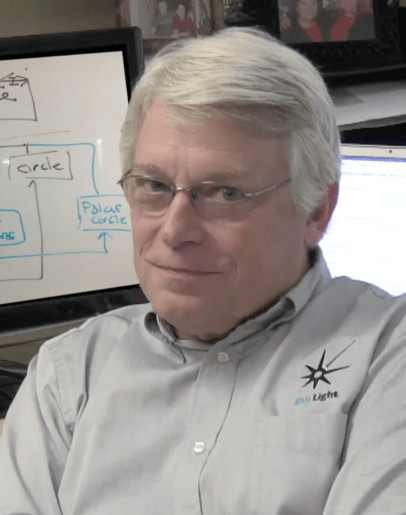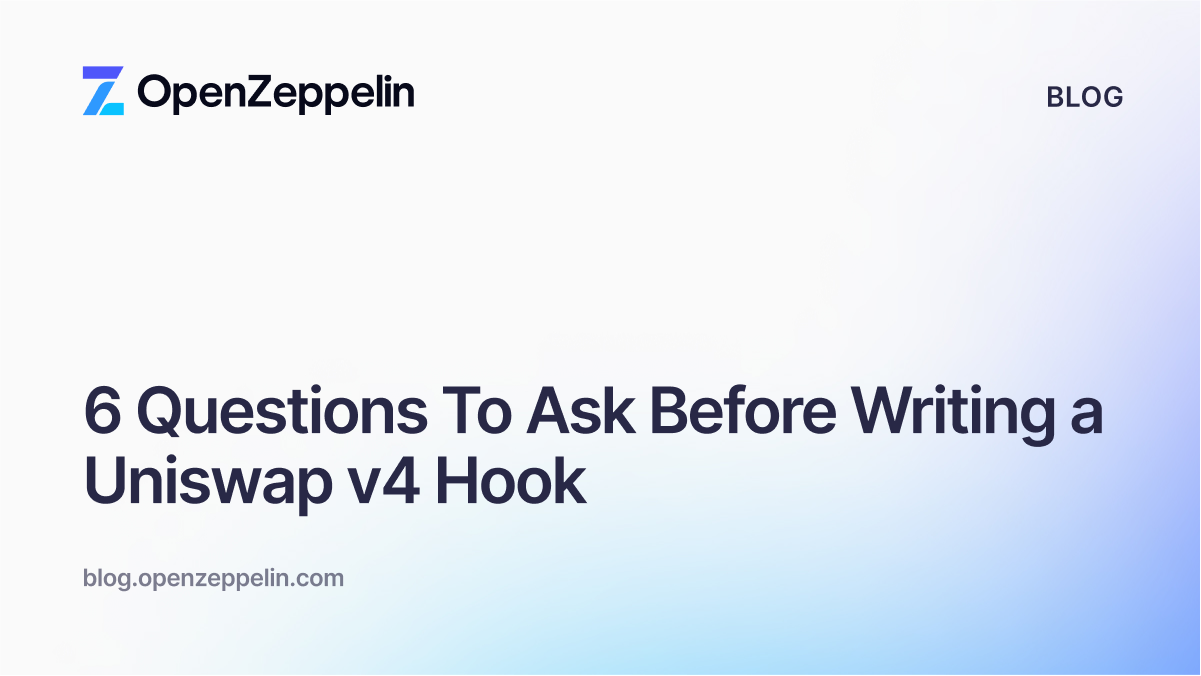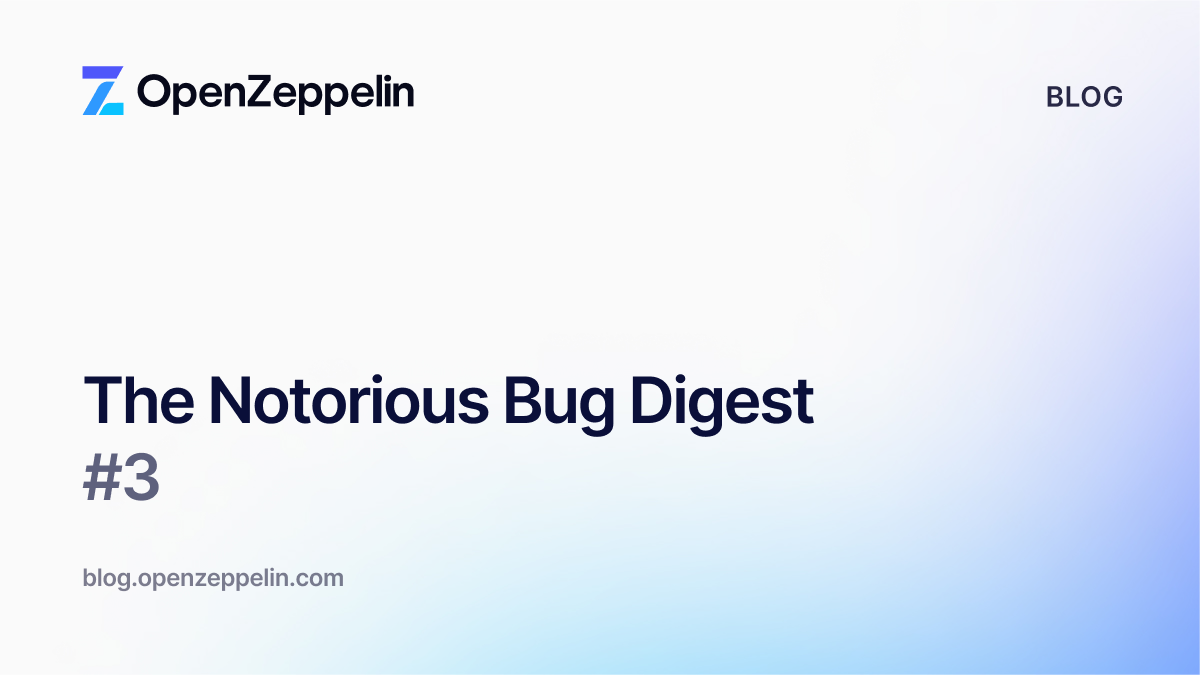
Originally written by Leo Arias
Thank you for your interest in this post! We’re undergoing a rebranding process, so please excuse us if some names are out of date. Also have in mind that this post might not reference the latest version of our products. For up-to-date guides, please check our documentation site. You can see the latest version of this document here.
At OpenZeppelin we help protect the core infrastructure of open and decentralized applications. I’m part of the Research team, which is in charge of conducting security audits. We review tons of lines of code written by very smart developers for projects that will shake the foundations of our society.
Finding security vulnerabilities in this futuristic cypherpunk environment is super challenging and fun, but we have already covered those topics elsewhere. I think that security actually starts in a pretty boring and traditional place, full of the wisdom that our elders have collected through millennia of developing software in community. Standing on their shoulders, I now want to share our checklist for basic quality measures that your next awesome project should consider before you hand it over for an external audit.
✔️ Choose a free software license
Closed code is inherently insecure. If people who use your project can’t inspect it, study it, hack it, and experiment on it, there’s no way it can be trusted. If you hold abusive control over your users, nothing prevents you (or anyone more powerful than you) from making them vulnerable.
Take a look at the Free Software Definition, and begin with choosing the license that best suits your needs.
Update: previously we introduced here Richard Stallman as a wise elder, dressed as a saint 🤦. This joke no longer seems appropriate due to his repeated bad comments, brought to light by a recent controversy. Let’s just say that we thank him for having hacked copyright laws, for starting the free software movement, and for writing the above definition. And that we consider appropriate him stepping down from his leadership position in the free software community.
✔️ Build your core team of maintainers
When your project succeeds, hundreds of external contributors will surely be supporting it. But in order to get to that point, you’ll need to bootstrap with a strong and diverse team of core maintainers. They’ll take care of the bulk of the work, the fun and the boring parts, proposing and reviewing the code of your shared project. Together, you all need to have strong knowledge of all points on this checklist. Look not only for technical knowledge, but also for a knack for cat-herding and a healthy work style — because, well, things will get complicated.
Pay attention to your bus factor: make sure your team members are sharing their expertise, the lessons learned, and their responsibilities, while at the same time constantly mentoring new people that could potentially join the core team.
And somebody will have to lead and orchestrate in order to get value out of the eternal tendency toward chaos. Let me introduce you to the magician, Camille Fournier, who wrote THE book on technical management, The Manager’s Path.

✔️ Write clean code
The only valid measurement of code quality is WTFs per minute. This point must be simple. If things get overly complicated or weird, you’re doing it wrong. Go for a walk and try again with fresh eyes.
But don’t get me wrong: no interesting software project is simple. Add the complexity dimensions of decentralization, transparency, cryptography, and all these shiny ideas that are keeping us so busy these days. It’s complicated by design. But with the correct abstractions, a well thought-out model, and proper encapsulation, you can start building the bank-killer app one line at a time. And each of those lines must be clean and readable.
I’m not a spectacular programmer, I was just lucky to find Uncle Bob Martin’s book Clean Code at the right moment and to have read a never-ending stream of very, very ugly code.

Once all core maintainers reach common ground on this topic, you should enforce a consistent code style by running a linter on every new line of code that’s added. The particular rules aren’t as important as following them strictly is, but if you can sacrifice your peculiar preferences to be consistent with the rest of the world, your contributors will appreciate it a lot.
I also practice slow-food… er, slow programming. Take your time, enjoy the journey to mastering this craft, and when you’ve built something you can proudly set free, let the masses read it and judge it.
✔️ Write unit tests
Write unit tests. Tons of them. 100% coverage. This might sound extreme, but hey, your code is now playing directly with somebody else’s money. If you forget, or just get lazy and don’t write a test for that super obvious line of code, you might be leaving an open door for an exploit later in the game that will make your project crash, and all this magic internet money will disappear in no time. It has happened.
I feel immediately more secure when I do test-driven development. At least give an honest try to writing the tests first, and get into a cycle of red-green-refactor. There are other techniques that can achieve the same result, but I suggest starting there and then deviating if you find good reasons to do so. Never worked this way? Read Test Driven Development: By Example by Kent Beck. It’s a quick read that will help you avoid the temptation of just jumping into code without thinking it through.
Then, even if you design for testability, you’ll find many scenarios that are hard to test. Gerard Meszaros provides all the answers in xUnit Test Patterns. This book is huge, so I recommend choosing a designated test expert on your team.


Finally, make sure to run your unit tests on every single pull request, and make sure they’re all green before merging the changes. In addition, you can set up a test coverage report to ensure that test coverage never goes down.
✔️ Test early, test often, test agile
Now that you have your first layer of tests covered with tons of unit tests, what comes next is…more tests! You need to test the integration between all of your components, then go one level higher to test your application from the point of view of a real user, and then go even higher to test the interactions with other systems end-to-end.
To me, this is the biggest challenge, and designing a good process that keeps many bugs out of your system can be as difficult as designing the system itself. Iterate, automate as much as possible, share the load of manual testing…and let your community help.
We’ll talk later about community, but I think this is the reason for publishing your code as early as possible: you can get help from early adopters and enthusiasts to validate your system, not only for correctness but also to verify that you’re focusing on the right user stories and that you’re tackling a real problem with a user-friendly solution.
A lot has been written about iterative development processes that deliver functionalities in progressive sprints and milestones. I found Mike Cohn’s Succeeding with Agile: Software Development Using Scrum a good place to start, but keep in mind that any methodology will have to be adjusted to your team, your users, and your context. There are a lot fewer resources focused on the quality and testing part; that’s why I was so happy when I read Agile Testing by Lisa Crispin and Janet Gregory, which is full of good ideas and advice. But let me stress again: nothing you read will perfectly fit your project, so take your time to design the testing process with as much love and care as you use when designing the system’s architecture.


While there’s still some debate about the perfect moment for auditing a project (i.e, before or after the code is published), I think audits should be performed when there’s a release candidate ready to be deployed to mainnet, after you have performed extensive alpha and beta testing. I see room for auditing before the code has been published, but in this case, the audit would be more related to checking that the development process will lead to a high-quality, properly tested release candidate and validating the bases of your project than to performing a deep and thorough inspection of the codebase.
However, this doesn’t mean that you have to wait until the end of a long development phase to prepare for a release and audit. Once you start writing and testing clean code in incremental iterations, it becomes easier to think about your complex system. Many smaller independent parts will start to pop up, which can be extracted, generalized, and packaged for reuse, reducing anxiety for developers and auditors.
✔️ Write documentation
This is my least favorite part, by far. So let’s keep it simple, starting at the beginning: the README, the most important file of your repository. And yet, it’s usually either empty or bloated, outdated, and ugly. Ideally, as it’s the first thing developers and potential contributors will read, it should work as a clear, straightforward index of your project.
It’s best not to get creative here. Just follow this simple specification that works for all cases, proposed by Richard Littauer in Standard Readme. Do not forget to include a specific section in the main README that states how people should disclose any security vulnerabilities found in your project.

Next come the docstrings, the documentation inside your code files. We hit an apparent conflict here, since in theory, if your code is clean, it will not require documentation. However, note that we are no longer designing standalone systems that work as a black box. We are building protocols for decentralized applications, and your code will be called by all sorts of external agents. So by all means, document every function that’s part of the contract’s public API, following the NatSpec format.
Which brings me to the next point. I highly recommend that you document the specification of your protocol — that’s how others will know what to call and what to expect. But more related to the topic at hand, in an audit, we check that the implemented code works as intended by the specification. That’s why this document is a must: without it, auditors will just guess at your intentions, which might result in some issues getting missed because they’re completely consistent within the system but take it to a state that you want to avoid.
Finally, there’s the user documentation. For high-quality systems, writing the user documentation should be mostly painless. The moment things get cumbersome while documenting, consider re-evaluating your user stories, and don’t be afraid to go back to iterate on them.
✔️ Check your dependencies
Your project builds on top of many, many others. It will probably depend at least on the Ethereum protocol and its network of nodes, and on Solidity, a bunch of Ethereum Improvement Proposals and their implementation, libraries for testing and UI, and maybe hundreds of other small projects. Even if yours is secure, you need to check how healthy your dependencies are, since they can easily become the source of vulnerabilities.
Earlier, I mentioned that your team should have strong and diverse knowledge. That includes knowledge of all the projects that surround you. You should be able to write idiomatic code following the best practices of the language, to identify and avoid known issues, always keeping an eye on new CVEs that may directly (or indirectly, through third-party dependencies) affect your project. Moreover, try to participate in the communities around your dependencies, as it’s an excellent way to see firsthand how safe and trustworthy they are. You should also consider actively participating in those communities, to gain some karma that will surely come in handy later when you need new features and bug fixes.

Moreover, don’t forget to pay attention to your dependencies’ finances. When making your project’s budget, take into account a share for your dependencies, as they may need it in order to remain actively maintained. There’s a very nice project called OpenCollective, led by Pia Mancini, which is making it extremely easy to transparently support the organizations and developers you depend on.
Specific to Ethereum and Solidity, the community is collecting the lessons learned (usually in a painful way). You can learn a lot about interesting and tricky vulnerabilities playing the Ethernaut capture-the-flag game. We’ve published many of our past audits with descriptions of the issues found, recommendations, and usually a link to the patch that fixes them. All of our learnings from audits are distilled into the OpenZeppelin package, which you should definitely add to your list of dependencies — if you’re not one of the thousands that already did. The Smart Contracts Weakness Registry maintained by the Mythril team is also a great resource for learning from the experience of others.
Whatever approach you take, remember that as the Ethereum space is very young and unexplored, we’re learning many things as we go, so always proceed with caution.
✔️ Build your community
This is a complement to the first point: code without a community is insecure. The community gives you eyes to monitor the project, hands to test it in a real environment, support to survive challenging problems, and resilience to adjust to the unexpected. No amount of money, experience, or knowledge can substitute for this.
Once you publish the code, you can get started engaging your community. If your project is interesting, they will come, and this is where the cat-herding abilities of your team will shine. However, you definitely need to set up proper and fluent communication channels, invest in some marketing, and hire a bold community manager with a plan to disentangle and wisely leverage all the opportunities your community brings. I can’t recommend highly enough the writings and videos by Jono Bacon, who has covered all the topics you can imagine about community management.

You should be thoughtful and caring with your community. A small step that goes a long way is to adopt and enforce a code of conduct so you can all feel safe. Then, write some contribution guidelines to make sure that all of their enthusiasm can be put to good use and they don’t get lost. Lastly, think about setting up a bug bounty program that will encourage your community to watch out for vulnerabilities in the wild, providing hackers with enough incentives to disclose security issues in a responsible way.
tldr:
✅ Choose a free software license.
✅ Build a strong and diverse team of core maintainers.
✅️ Increase your bus factor: share knowledge and responsibilities.
✅ Choose a good leader.
✅️ Write clean code.
✅️ Enforce a consistent code style.
✅️ Ensure 100% unit test coverage.
✅️ Enforce green tests on all your pull requests.
✅️ Design your iterative development and testing process.
✅️ Publish your code.
✅️ Write a good README.
✅️ Document the functions of your public API.
✅️ Document your protocol.
✅️ Write the end-user documentation.
✅️ Make sure that your dependencies can be trusted.
✅️ Review known issues and keep an eye out for new ones.
✅️ Use OpenZeppelin Contracts, the community-vetted standard for smart contract development.
✅️ Build and care for your community.
Ready to hire an auditing team?
That’s us! 🙂 The OpenZeppelin team can help you assess the quality of your project and processes. We’ll take a deep and thorough dive into your code, with years of experience hacking, researching, and developing on blockchains, plus a little touch of Latin American fire, to give you and your users all the confidence you need to continue building the core systems of this new decentralized, global, and open economy.
Thanks to Martín Abbatemarco for editing this post, to the OpenZeppelin team for the continuous experimentation and feedback, and to our customers for trusting us and helping us better understand what makes a free software project awesome.
Originally published at elopio.net on February 8, 2019.


